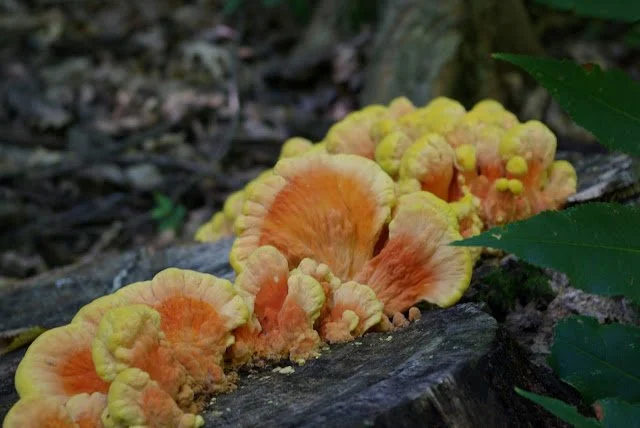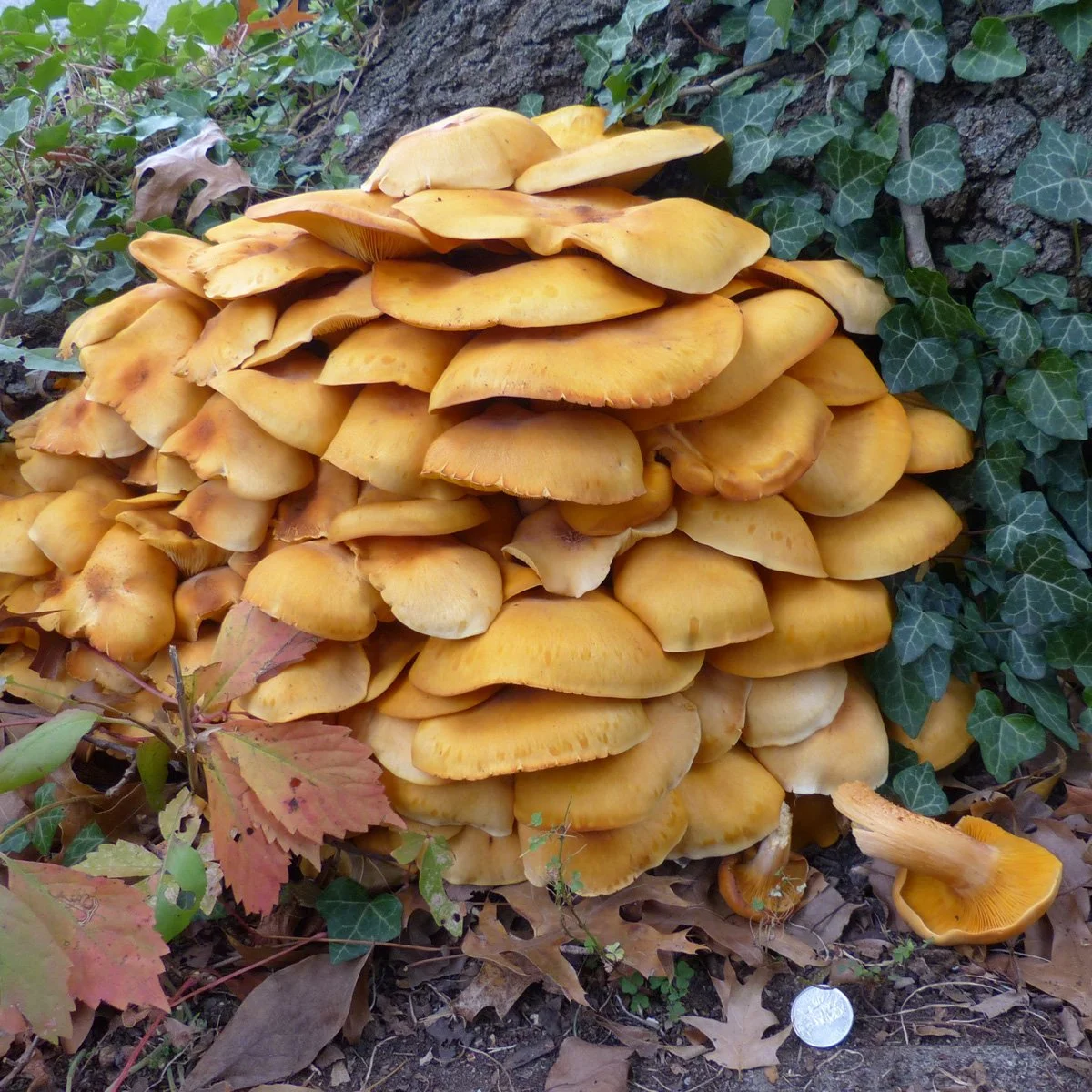Foraging and Cooking with Chicken of the Woods Mushrooms
Sulfur shelf mushrooms thrive in my woods and in forested areas across much of the United States and beyond. These colorful fungal critters are treasured by mushroom hunters everywhere because they’re so easy to spot and identify. And on top of that, they’re undeniably delicious. Never tried them? Give them a taste! I’ll bet you’ll become a fan of their rich, umami-packed flavor and satisfyingly meaty texture.
Whenever someone tries an umami-forward food for the first time, they often exclaim, “It tastes like chicken!” That’s probably why the common name for this mushroom is “chicken of the woods.” With its savory profile, chicken of the woods can easily stand in for chicken in a variety of recipes, adding depth and heartiness to any dish. It goes without saying that chickens everywhere support this substitution!
If you’re new to mushroom hunting, this is a great mushroom for beginners. Read on to learn how to forage for these culinary gems—and stick around for a great recipe to make the most of your harvest!
Chicken of the Woods
Unlike other mushrooms that hide under the leaf litter on the floor of the woods, these guys grow on stumps and trees. And unlike other mushrooms that are camouflaged by their color, these little fungus dudes, with their orange and yellow coloring, can’t be missed. It’s almost like they’re jumping up and down, waving their little mushroom arms, and yelling, “Here I am! Here I am! Sautée me! Right now!” Also, because it is fairly difficult to confuse this mushroom with another mushroom that might be less edible or poisonous, mycologists include it in the list of the “foolproof four” that beginners can safely forage.
Exactly which four mushrooms are included in that list of four seems to differ depending on which mycologist you’re talking to, but everybody includes sulfur shelf mushrooms among the four on their list. (The term “foolproof four” which so many mycologists bandy about was coined, as far as I can tell, by Clyde Christensen in his 1943 book Common Edible Mushrooms. His list: morels, puffballs, sulphur shelf mushrooms, and shaggy manes.)
If you’re in the woods any time from late spring through late summer when these mushrooms are growing, you won’t miss them. As a matter of fact, you’ll see them from a distance! Their bright orange tops and yellow undersides and margins stand out like neon signs. They grow in clusters on stumps, logs, and dead or living trees—almost always oaks. Each mushroom or “shelf” can range from a couple inches to a couple feet in size.
When the weather conditions are right, they’ll reliably show up on the same tree or stump year after year. Their growth on living trees is problematic since they digest the wood, thus weakening the structural integrity of the tree. By the time an infected tree has visible mushroom growth on the outside, it is doomed and will probably come crashing down during the next big windstorm. That’s bad news for the tree, but good news for all the little trees in the understory looking for an open spot in the tree canopy so they can flourish. Also, it’s really good news for all of us who love to eat wild mushrooms!
The best part of the mushroom is the outer growing edge. If you break off a chunk and juices run freely out of the broken part, you’ve got some really good mushrooms. If, on the other hand, the mushrooms are tough, woody, and old, don’t even bother – they won’t taste good and won’t be worth your bother in collecting them.
These ‘shrooms are good sautéed in a little butter or olive oil, deep fried, boiled in a soup, or pretty much any other way you can imagine. Since I live in a mature oak woods, I enjoy this treat in the summer months on a regular basis. All the pictures that I’ve included in this article, btw, are chicken of the woods that I’ve found on my acreage.
Chicken of the Woods Cousins
The scientific name for the sulfur shelf mushroom is Laetiporus sulphureus, and it is a bracket fungus – the term given to mushrooms that grow on trees. Like most bracket fungi, L. sulphureus is a polypore—it has pores on its underside rather than the gills that many other mushrooms have. With the advent of DNA sequencing, mycologists have been able to take a closer look at this mushroom and have realized what everyone had thought was one mushroom species is actually made up of five different species that look almost exactly the same.
The latest taxonomy puts these five species into a "Laetiporus sulphureus species complex." While the species can’t be differentiated based on appearance, they can be fairly reliably separated based on the tree they grow on and the part of the country where they occur. The mushrooms still contained in the species L. sulphureus grow only east of the Great Plains and almost always on oaks. Mushrooms that look like L. sulphureus that are growing on trees other than oaks and/or are growing in the western US are probably NOT L. sulphureus and are possibly toxic. Knowing that there are different species that look identical but grow in different locations is an important point for mushroom foragers to remember.
The Cautionary Stuff
Some people who have consumed these mushrooms have had “mild reactions” such as swollen lips or in rare cases, “nausea, vomiting, dizziness and disorientation”. An editor’s note on the Cornell University Mushroom Blog mentions reports of “vomiting, chills, and perhaps mild hallucinations” but also notes that the majority of individuals—likely over 90%—consume these species without any issues.
It’s important to consider that many of the reports of adverse reactions to this mushroom date back to the time before there was any awareness of L. sulphureus’s look-alike species. It’s possible that these negative experiences were actually caused by one of the more toxic L. sulphureus doppelgangers. Also, keep in mind that many people enjoy foods like peanuts and shellfish, yet others suffer severe allergic reactions to them—even life-threatening ones. Similarly, while most people consume wheat and dairy with no problems, some are lactose intolerant or allergic to gluten. Mushrooms are no different—while many enjoy them without incident, some people may experience adverse reactions.
As of now, there doesn’t appear to be a confirmed toxin or allergen responsible for the negative reactions associated with this mushroom. However, the golden rule of foraging remains the same: always exercise caution. Start by trying a small amount, and if you feel fine a few hours later, you can enjoy more with confidence.
A Forager’s Guide to Laetiporus spp.
Sulfur shelf mushrooms grow in many parts of the world. Here’s a thumbnail description of the five species that grow in the US. While they are all similar in appearance, they can be differentiated by the trees they grow on and their geographical location.
Laetiporus sulphureus
Tree: Mostly living and dead oaks and oak stumps and logs.
Pore color: Bright yellow to orange.
Location: East of the Great Plains.
Edibility: It is considered the "classic" Chicken of the Woods. Wikipedia notes that only the outer margins are edible and that it shouldn’t be eaten raw. Wikipedia also notes the reports of “severe adverse reactions…in about 10% of the population” but suggests that “this is now thought to be the result of confusion with morphologically similar species.”
Laetiporus cincinnatus
Tree: Usually oak – grows on the tree roots, thus the mushrooms usually appear at the very base of a tree, or emerging from the soil.
Pore color: Cream to white.
Location: East of the Great Plains
Edibility: Mushroom enthusiast Steve Caruso suggests that while only the margins of L. sulphureus is palatable, “nearly every part of L. cincinatus can be eaten.”
Laetiporus huroniensis
Tree: Usually hemlock.
Pore color: Yellow.
Location: Great Lakes region.
Edibility: This species “seems to cause poisoning more often than true L. sulphureus” according to the Cornell Mushroom Blog.
Laetiporus gilbertsonii
Tree: Grows on both oak and eucalyptus trees.
Pore color: Yellow.
Location: West Coast.
Edibility: The Cornell Mushroom Blog reports that this species is “more frequently implicated in poisonings” than L. sulphureus. Flora Finder states somewhat ambiguously that it “is generally considered edible, but some people don’t respond well to it.”
Laetiporus conifericola
Tree: Primarily on conifer trees
Pores: Yellow
Location: West Coast
Edibility: The Field Guide to Mushrooms of Western North America deems this mushroom inedible and reports that some people experience gastrointestinal upsets after eating it. Flora Finder also labels it “not edible” and further reports it to be “sour-tasting and indigestible, causing nausea, dizziness, and possibly hallucinations.”
The poisonous jack-o’lantern mushroom, Omphalotus illudens
By Keith Miklas - Own work, CC BY-SA 4.0
For the sake of due diligence, I will also mention the eastern jack-o’lantern mushroom, Omphalotus illudens, which could be confused with chicken of the woods by inexperienced foragers because it is orange and grows on stumps and the base of certain hardwood trees. While it only superficially resembles chicken of the woods, it is quite poisonous, so one should be completely sure that the mushroom one is placing in one’s collection basket isn’t this bad boy. How to be completely sure: Flip it over! Chicken of the woods has pores; this guy has gills!
Eggs, Steak, and Chicken of the Woods
For the record, I’ve harvested, cooked, eaten, and enjoyed chicken of the woods a lot and the only reaction I’ve ever had is delight. Here’s one way I’ve prepared these tasty mushrooms. It’s the chicken of the woods version of a steak and eggs breakfast.
Everything in this concoction came from my acreage – except the beef, which came from a neighbor, the cheese, which came from a nearby dairy, and the olive oil which…. well, whenever they come up with an olive tree that grows in Minnesota, maybe I’ll be good for that, too!
The steak in this recipe is a frill. Remove it and not only does this dish become vegetarian, but it is still delicious.
Eggs, Steak, and Chicken-of- the-Woods
1 cup chicken-of-the-woods mushrooms, chopped
1 cup green onions (separate green from white and chop)
½ red pepper, chopped
1 cup left-over sirloin (cooked, cooled and cubed)
½ cup mild cheese, grated (I used a brick cheese from Star Dairy in Weyauwega, WI)
2 eggs (I used 3 small Silkie eggs)
1 tablespoon olive oil
1 tablespoon hot sauce (mine is homemade, but sriracha would work)
½ tsp salt
Whisk the salt and hot sauce into the eggs, set aside. Sauté the white part of the onion and the red pepper in oil in a medium sized frying pan for a minute. Add the mushrooms and sauté another 2-3 minutes. Add the beef and green onion and sauté for another minute. Remove the contents of the frying pan to a plate, add the eggs to pan and scramble. Add the mushroom/steak mix to the scrambled eggs, mix and plate. Top with cheese.
Want to try another delicious foraged mushroom/egg dish? Check out my recipe for Puffball Frittata!












